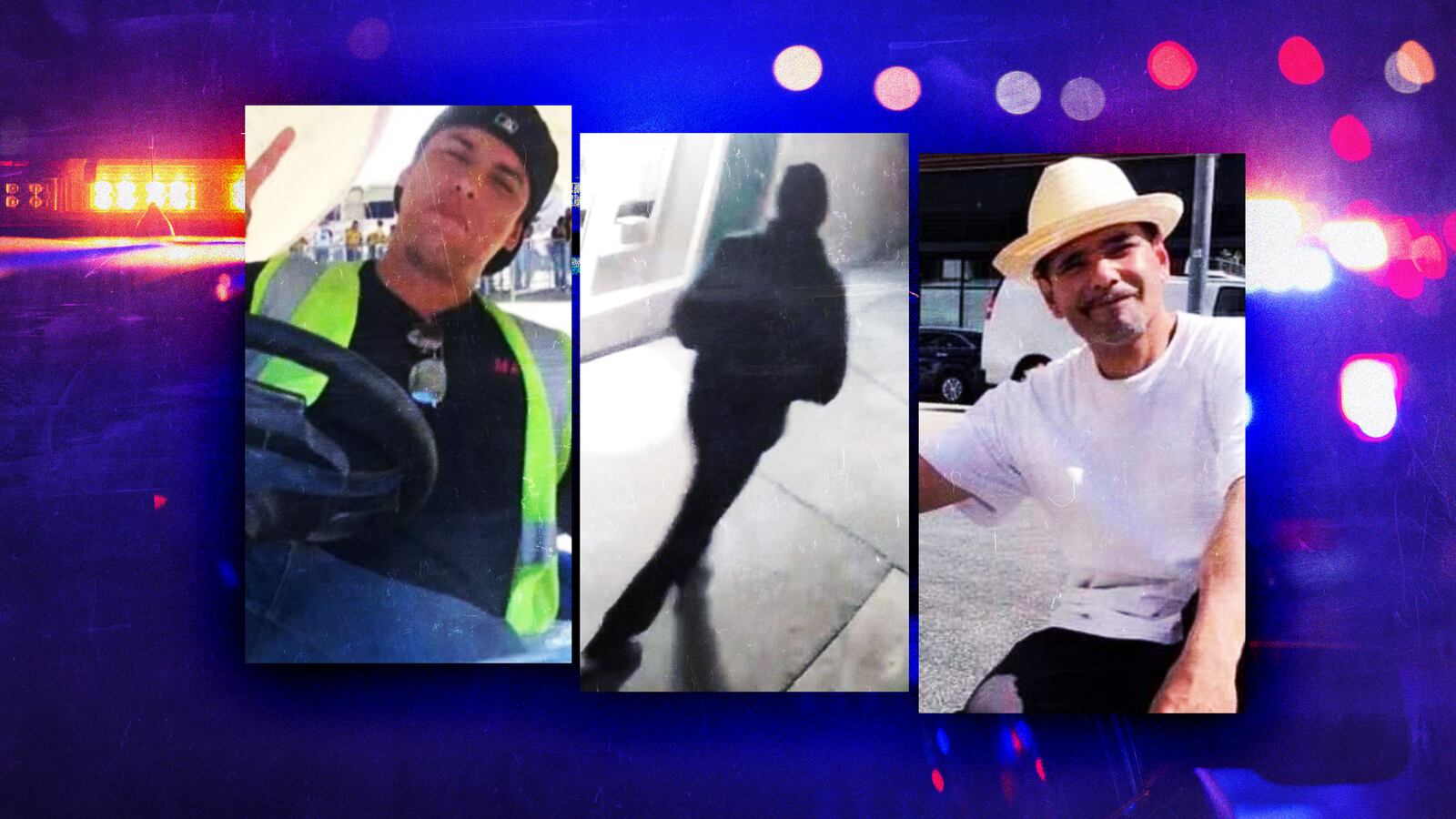Six dead and one survivor. One grainy piece of surveillance footage. The trail of death left by a suspected serial killer in Stockton and Oakland, California, has left these communities on edge. Now, the victims’ families and city residents are looking for answers.
The Daily Beast spoke to three experts on serial killers about who the Stockton killer might be, why he is killing, and how he might be caught.
All agree that the killer is likely local or very familiar with the Stockton area, plans out his crimes, and intentionally chooses vulnerable victims.
Enzo Yaksic, author of Killer Data: Modern Perspectives on Serial Murder, and a researcher at Atypical Murder Research Group, offered the most specific profile of the Stockton killer.
The killer is a male in his early thirties, Yaksic predicts, based on data his group has collected on serial killers, and lives in the same north Stockton neighborhood where most of his victims have been killed. He lives with close relatives who may not be aware of his activities.
He may be killing out of a need to appease intense feelings of anger, Yaksic says. Killing may be “the offender’s way of relieving the stress and pressure he experiences in daily life,” Yaksic told The Daily Beast by email.
He believes the reason so many of the victims were homeless is because they were easy targets.
“Part of the reason that many serial murderers target the unhoused, beyond their inherent vulnerability, is that they reside in unmonitored places and generally do not have devices such as cellphones that can record them,” Yaksic wrote.
But he also said that the killer may be homeless himself, or at least familiar with the community. Although most of the killer’s victims are Latino, police have said they do not currently believe the killings are hate crimes. The shooter may be Latino himself, Yaksic says, as the majority of serial killings are intra-racial.
He may be keenly watching the media coverage of his crimes, Yaksic says, and enjoying being “recognized for his deeds.”
Yaksic is confident the killer will be caught when someone from the community comes forward with information.
For the families of the victims, there are currently more questions than answers about the person who took the lives of their loved ones.
“Who does that? What kind of monster does that?,” William Debudey, the uncle of victim Salvador Debudey Jr., asked in an interview with The Daily Beast on Wednesday. Debudey Jr., known as “Sal” to family and friends, was shot to death in the parking lot of a Popeyes on Aug. 11, while trying to buy dinner.

Police believe that Salvador Debudey Jr, Lorenzo Lopez, and Paul Yaw were all killed by the same person.
Family HandoutsThe 43-year-old was the third of six known victims of a shooter who the Stockton Police Department now believes is a serial killer.
The first, Juan Miguel Vasquez Serrano, 39, who was homeless at the time of his murder, was shot in on a street corner in east Oakland on April 10, 2021. Six days later, and 70 miles away, Natasha Latour was shot outside her tent in an industrial neighborhood of Stockton. She survived the attack.
For more than a year, the killer did not strike again. That changed at the beginning of the summer, when Paul Yaw was shot in a small park in a residential neighborhood of north Stockton in the early hours of July 8. Yaw was also homeless at the time of his death. Just over a month later, Salvador Dubudey Jr.,was slain in a Popeyes parking lot.
Three more men would die in the weeks that followed, all in the same five-mile radius of north Stockton. On Aug. 30, Jonathan Hernandez Rodriguez, 21, was shot while sitting in his car outside the apartment complex where he lived off East Hammer Lane. On Sept. 21, Juan Cruz, 52, was shot outside an apartment complex on Manchester Avenue.
Finally, in the early hours of Sept. 27, Lawrence Lopez Sr., 54, was killed on Porter Avenue. Lopez was a father of six children, and an aspiring musician.
Jerry Lopez, Lawrence’s brother, said he felt confident the police would soon capture his killer.
“They’re getting close to this guy,” he told The Daily Beast on Wednesday, “I can feel it.”
Investigations like this one take collaborative police work, thorough crime scene analysis and forensic witness interviews, says Jeffrey Rinek, a retired FBI agent. As well as a bit of luck.
Rinek served with the FBI for 30 years. In his long career he worked serial murder cases, and specialized in cases involving children. For several years, Rinek worked out of the FBI field office in Sacramento, only 50 miles from Stockton.
Rinek says we should be careful not to make assumptions about the perpetrator, and emphasized that very little information has been made public by police. However, having reviewed the case, he gave his thoughts about the killer.
“I believe that the offender was making an effort to ensure he or she was alone with the victim, and that the area would be safe. I believe that the offender is taking measures to lower the risk factor of the crimes,” he said, pointing out that this means the crimes are probably planned and not spontaneous.
Rinek said the locations and timings of the crime suggest the killer may be surveilling his victims prior to attacking them, making sure he approaches under the cover of darkness while they are isolated.
The close proximity of five of the shootings—clustered in north Stockton—suggests to Rinek the perpetrator may know the area well.
“If you took all these locations, and determined the center of them, what would be there?,” he says, “It’s very possible that the offender is living right there.”
Two of the shootings stand out to Rinek as different from the others. The first known shooting took place in Oakland, 70 miles from Stockton, when Juan Miguel Vasquez Serrano was killed on April 10, 2021.
Rinek said that if he was investigating the case, he would be looking closely at that killing, as well as the shooting of Natasha LaTour, the killer’s lone surviving victim.
LaTour now believes the subsequent killings could have been prevented if law enforcement had taken her story seriously. She says they dismissed her because she was homeless at the time.
“Five people died because they didn’t listen to me,” LaTour told a local outlet.
The fact that LaTour survived shows the killer is not infallible, Rinek says. “That means the offender made a mistake. You can tell from the mistake they make what they’re trying to do,” Rinek says. If he was investigating, he would ask himself: what went wrong that night?
LaTour, described the shooter as wearing dark pants, a dark hooded sweater and a black mask, in an interview with a local outlet 209 Times. Rinek says this is key, because it shows the perpetrator is trying to conceal their identity.
LaTour was shot at least nine times, she says. That makes Rinek think the weapon is probably a semi-automatic pistol, capable of firing several rounds quickly.
While police have not confirmed a single weapon was used in the slayings, Stockton police chief, Stanley McFadden, suggested during a Tuesday press conference that a pistol may be involved.
“I have absolutely no answer as to why that pistol went dormant for over 400 days,” McFadden said of the weapon used to shoot LaTour, and then, over a year later, to kill Paul Yaw.
It is this gun that may prove key to identifying the killer. Police have implied that they have ballistic evidence that links all seven shootings. Rinek says it’s interesting the police have chosen to make that information public.
“Now the offender knows to get rid of that gun,” he says.
Robert Shug, a forensic psychologist and a professor of criminology and forensic psychology at California State University Long Beach, usually encounters serial killers when he interviews them after they’ve committed their crimes and been caught.
In this case, he is watching a case unfold in real time, with a perpetrator still at large. Schug, like Rinek, believes understanding the victims is important.
“Serial killers kill people who are vulnerable, who they can overpower easily,” Schug says, pointing out that many of the victims were homeless and all but one were male. It’s unusual, he says, to see a serial killer targeting men.
“These may be victims of convenience,” he said, pointing out that the killer strikes at night, “Are these just people who are out and about?”
In a way, Schug says, it is the randomness of these killings that makes them so terrifying.
“It could be anybody. And the victims could be anybody,” he says.
“We don’t know what the motive is. What we do believe is that it’s mission-oriented,” Stockton Police Chief Stanley McFadden said on Tuesday, “This person’s on a mission.”
Schug says this is an interesting choice of words that implies the police may know more than they are letting on.
“That’s implying that there’s evidence to suggest this person may be going around serving some higher purpose,” he says. What the killer may think that purpose is, Schug doesn’t know. It’s too soon to speculate, he says. There is simply too little information.
Police have released a single grainy video of a person of interest. A surveillance camera captured a person walking away—their back to the camera. There’s little that would help identify the person, other than a slightly unusual walk. Schug says it’s not much for law enforcement to go on.
Nonetheless, he’s confident the shooter will be caught, either through diligent police work, luck, or both. The ubiquity of cellphones, smart doorbells and security cameras will mean that sooner or later, a clearer image of the perpetrator will be captured, he says.
“That’s going to make it harder for this guy to keep going,” Schug says. “I don’t think he can keep doing this in Stockton much longer and getting away with it.”
For now, the Stockton police say they are considering every possibility, as they receive hundreds of tips every day. The police “still don’t know if it’s just one, or two, or multiple suspects,” Officer Joseph Silva, a spokesman for the Stockton Police Department, told The Daily Beast earlier this week.
The FBI are now assisting local law enforcement. A $125,000 reward is being offered for information leading to an arrest.
In the meantime, there is little reassurance for the people of Stockton and Oakland.
“The fact remains that this offender feels comfortable walking dangerous streets alone at odd hours because they are supremely confident in their own ability to react with an extreme level of violence,” Enzo Yaksic told The Daily Beast.








